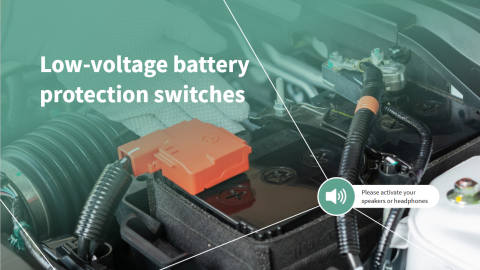12V-24V Battery Management System (BMS)
Infineon’s 12 V to 24 V BMS accurately monitors, protects, and optimizes battery performance. This automotive battery management system features low-power standby modes for diagnostics, monitoring SOC, SOE, SOH, SOP, SOS, temperature, cell voltages, and currents (including quiescent currents) of cells and the vehicle.
Click the block diagram to check Infineon's highly integrated and space-saving offers, including supply IC, microcontroller, monitoring IC, balancing IC, pressure sensor, gate driver, power MOSFET, and transceivers.
Check out more details on Battery Management System (BMS)
Ensure 12V and 24V battery availability and diagnosis at all time with ultra-low standby power consumption
Low-voltage 12V and 24V batteries are important for ensuring the power availability of the low-voltage bus in passenger and commercial vehicles. The key function of the low-voltage availability battery is to:
- Stabilize the low voltage bus by ensuring the constant 12V and 24V supply during different operation modes.
- Ensure the availability of the low voltage bus for safety-critical functions, in case of any loss of the main energy source (e.g. engine or traction battery). Such safety-critical operations included steering, braking, door locking or unlocking, and many others.
The low voltage BMS is especially important for xEVs, due to the main characteristics below:
- High cycle frequency: Low voltage battery is drained much more frequently on an EV than on an internal combustion engine (ICE) vehicle, because it's always on to keep EV controlled remotely, maintain the charging of high voltage (HV) battery and BMS communications
- Low recharge currents: It’s not charged as frequent as on an ICE, in order to save power for HV battery to achieve longer range
Solutions for all Subfunctions of BMS
- Disconnecting the battery during safety critical events or off mode.
- Managing inrush currents during the turn on phase.
- Reliable storage of boot code to ensure safe and dependable operation.
- Monitoring vital parameters and logging them into a fast-write, high endurance NVM, as the data need to be retained when the battery is switched-off in controlled or uncontrolled fashion.
- SoC and SoH calculations rely on previous state information of the cell and discharge rate.
- Running the BMS software, including:
- Controlling all the cells & pack monitoring units.
- Collecting all the monitored values.
- Calculating the various states of the battery (e.g. SOC, SOE, SOH, SOP, SOS, etc.)
- Performing housekeeping.
- Updating the BMS firmware (e.g. SOTA and FOTA)
- Detecting:
- Thermal runaway.
- Over current (OCD)
- Monitoring
- Battery disconnection states.
- Monitoring:
- Battery packs current and detecting over current events.
- Ultra low power quiescent current monitoring during parking mode.
- ASIL rated wake-up monitoring.
- Warning the battery control unit or triggering the battery disconnect unit when pack failure modes are detected.
- Sensing the voltages and temperatures of battery cells.
- Balancing and matching battery cells to optimize the battery packs performance.
- Reporting any failures or out of specification operations of the cells and CMU circuitry

- Know how a typical battery protection switch works and the importance of MOSFET avalanche robustness
- Identify the best-in-class Infineon offerings of demo boards, MOSFETs and gate drivers

- Get an overview of the main features of this flexible EiceDRIVER™ device
- Understand its different integrated protection mechanisms



